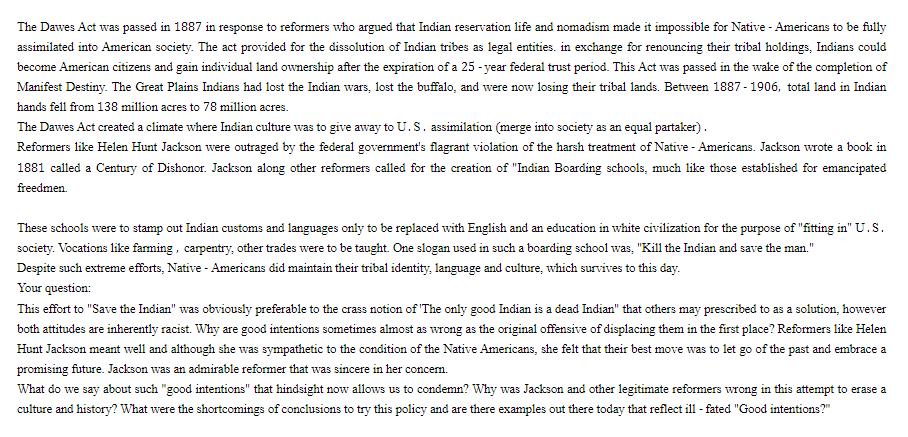Answered step by step
Verified Expert Solution
Question
1 Approved Answer
The Dawes Act was passed in 1887 in response to reformers who argued that Indian reservation life and nomadism made it impossible for Native

The Dawes Act was passed in 1887 in response to reformers who argued that Indian reservation life and nomadism made it impossible for Native - Americans to be fully assimilated into American society. The act provided for the dissolution of Indian tribes as legal entities. in exchange for renouncing their tribal holdings, Indians could become American citizens and gain individual land ownership after the expiration of a 25-year federal trust period. This Act was passed in the wake of the completion of Manifest Destiny. The Great Plains Indians had lost the Indian wars, lost the buffalo, and were now losing their tribal lands. Between 1887-1906, total land in Indian hands fell from 138 million acres to 78 million acres. The Dawes Act created a climate where Indian culture was to give away to U.S. assimilation (merge into society as an equal partaker). Reformers like Helen Hunt Jackson were outraged by the federal government's flagrant violation of the harsh treatment of Native Americans. Jackson wrote a book in 1881 called a Century of Dishonor. Jackson along other reformers called for the creation of "Indian Boarding schools, much like those established for emancipated freedmen. These schools were to stamp out Indian customs and languages only to be replaced with English and an education in white civilization for the purpose of "fitting in" U.S. society. Vocations like farming, carpentry, other trades were to be taught. One slogan used in such a boarding school was, "Kill the Indian and save the man." Despite such extreme efforts, Native Americans did maintain their tribal identity, language and culture, which survives to this day. Your question: This effort to "Save the Indian" was obviously preferable to the crass notion of 'The only good Indian is a dead Indian" that others may prescribed to as a solution, however both attitudes are inherently racist. Why are good intentions sometimes almost as wrong as the original offensive of displacing them in the first place? Reformers like Helen Hunt Jackson meant well and although she was sympathetic to the condition of the Native Americans, she felt that their best move was to let go of the past and embrace a promising future. Jackson was an admirable reformer that was sincere in her concern. What do we say about such "good intentions" that hindsight now allows us to condemn? Why was Jackson and other legitimate reformers wrong in this attempt to erase a culture and history? What were the shortcomings of conclusions to try this policy and are there examples out there today that reflect ill-fated "Good intentions?"
Step by Step Solution
There are 3 Steps involved in it
Step: 1
Good intentions while wellmeaning can sometimes lead to harmful outcomes when they fail to consider ...
Get Instant Access to Expert-Tailored Solutions
See step-by-step solutions with expert insights and AI powered tools for academic success
Step: 2

Step: 3

Ace Your Homework with AI
Get the answers you need in no time with our AI-driven, step-by-step assistance
Get Started


